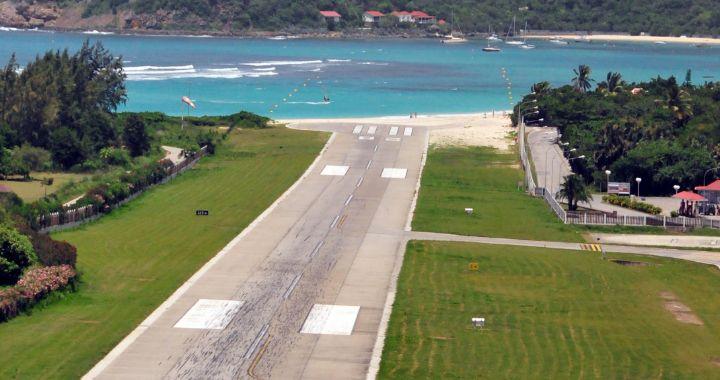St. Barts is a small island located in the Caribbean that is famous for its beautiful beaches and luxurious resort. This stunning island is pristine, peaceful, and unspoiled by mass tourism, making it the perfect place to unwind and relax. However, what makes St. Barts unique for aircraft enthusiasts like us, is its airport.
St. Barts Airport is known to have the shortest runway in the world, making it one of the most notorious and dangerous airports to land in. Moreover, it’s situated between high hills and cliffs, making take-offs and landings quite challenging. Despite this, the airport on St. Barts is popular with seasoned pilots, adventure seekers, and tourists who love the excitement of a unique landing experience.
There’s nothing quite like the feeling of anticipation as you fly into St. Barts for the first time. So, for anyone flying to St. Barts, you won’t want to miss this post dedicated to everything you need to know about the airport.

St. Barts Airport Runway Length
St. Barts Airport, also known as Gustaf III Airport, is widely considered one of the most dangerous airports in the world due to its short runway length and steep descent. However, despite this reputation, the airport has an excellent safety record and is a popular destination for many travelers to the Caribbean.
With a runway length of only 2,133 feet and a landing approach that’s both thrilling and slightly unnerving, St. Barts Airport is a destination that’s sure to leave an impression.
The runway at St. Barts Airport starts at the edge of the water and ends just before a steep hill. This means that pilots have to make a quick stop after landing to avoid heading toward the hill at the end of the runway. If you’re a traveler flying into St. Barts, the short runway and steep descent can be an eye-opening experience. However, once you’ve landed, the airport is incredibly convenient. And, even better, it is located just minutes from the beaches, hotels, and restaurants on the island.
For pilots, landing at St. Barts Airport can seem like a challenging and intimidating task. But the airport has an excellent safety record and is considered one of the safest airports in the Caribbean. The airport requires pilots to have special training and certification to land at the airport due to its unique runway conditions.

St. Barts Airport Info
What makes St. Barts Airport unique?
Well, the airport might be small, but it packs a punch with its breathtaking views and exciting approach for pilots. Ready for takeoff? Here’s everything you need to know about St. Barts Airport:
- Airport Name: Gustaf III Airport
- Airport Code: SBH
- Runway Dimensions: 650 meters (2,132 feet) long, with a narrow width of 20 meters (66 feet)
- Opening Hours: The airport opens at 7:00 am and closes half an hour after sunset. Please note that night-time landings are not permitted.
- Airlines: Only regional airlines such as Air Antilles, Tradewind Aviation, and Winair operate flights to and from St. Barts Airport.
- Aircraft Allowed: Due to the short runway and challenging landing conditions, only smaller aircraft such as the Twin Otter, Britten-Norman Islander, and Cessna Caravan are allowed on the runway.
The airport’s location also makes it a popular spot for plane spotters and beachgoers. Despite its challenges, St. Barts Airport remains an important gateway to the popular tourist destination of St. Barthélemy.

Flying Into St. Barts Airport
Flying into this airport requires skill, experience, and preparation. If you’re planning a trip to St. Barts, here are some tips and recommendations to help you arrive safely and smoothly.
Know your route.
If you’re flying to St. Barts, you’ll need to take a connecting flight from a nearby island. The most popular option is to fly into St. Maarten’s Princess Juliana Airport, which is approximately a 15-minute flight away. From there, you can take short, chartered flights or scheduled flights offered by various airlines such as St. Barth Commuter, Tradewind Aviation, and Great Bay Express. These flights usually take around 10-15 minutes to reach the Gustav III Airport in St. Barts.
For those who prefer to fly from San Juan or Grand Case, there are also chartered flights offered by a charter broker. These flights are usually operated by smaller aircraft, and they provide a direct flight experience to St. Barts.
Choose the right aircraft.
Gustaf III airport is so small that commercial planes cannot land or take off from the runway. This means that the only options for getting to St. Barts are to take a smaller aircraft or travel by boat. The type of aircraft you fly can affect your approach and landing at St. Barts Airport.
The most recommended aircraft for this airport are turboprops, light jets, and single-engine planes with good short-field performance. Examples of popular models are the Pilatus PC-12, the Cessna Caravan, the King Air 200, and the Citation CJ3. Avoid heavy jets, widebody planes, or aircraft with limited maneuverability and braking power. It is also important that your aircraft is properly fitted with a Jetbed to ensure you are comfortable all through the trip.
Secure the right certifications.
Pilots often need specialized training and certification to navigate the runway effectively. Before you fly into St. Barts, you need to secure the right certifications and training. Private pilots and commercial pilots must complete a special training program provided by a recognized instructor or training center that includes ground instruction, simulator training, and at least three touch-and-go landings.
Also, you need to obtain a special permit from the French Civil Aviation Authority called “autorisation de piste courte” that which allows you to operate at St. Barts Airport.
Plan your flight carefully.
To avoid surprises and unexpected situations, you need to plan your flight to St. Barts carefully. A good idea is to use flight planning software or service that provides detailed information about the airport, the runway, the weather, the terrain, and the approach. Also, you should check the NOTAMs (Notices to Airmen) for any updates or changes in the airport operations or conditions. You should also consider hiring a local pilot or flight instructor to guide you through the landing process.
Observe the rules and regulations.
When flying into St. Barts Airport, you must observe the rules and regulations set by the airport authorities and the French Civil Aviation Authority. These include a maximum weight limit of 5,070 pounds, a maximum approach speed of 95 knots, a maximum angle of descent of 10.5 degrees, and a maximum takeoff run of 1,312 feet. Also, you need to comply with noise abatement procedures. Avoid low-level flights over populated areas, and respect the local wildlife and environment.
Flying into St. Barts Airport is always a thrilling and challenging experience.
Getting to St. Barts may require some extra effort, but it’s well worth it for those who want to experience the stunning beauty of the island. Whether you choose to travel by chartered flight or take a connecting flight from a neighboring island, you’ll be rewarded with a luxurious travel experience once you arrive. Remember to always prioritize safety over convenience or speed. And never hesitate to ask for help or guidance when in doubt.
For more answers to questions related to chartering a private jet or perhaps fractional ownership, consult our blog. If you’re looking for an easy and convenient tool that will help you avoid flight fatigue, explore our fleet of JetBeds. You will surely find one that best fits your aircraft and offers comfort and convenience on your travels.

